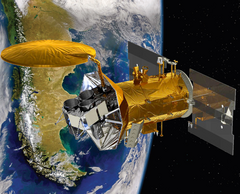Aquarius (SAC-D instrument)

Artist's concept of the SAC-D satellite
|
|
| Operator | NASA |
|---|---|
| Instrument Type | Radiometer |
| Function | Oceanography |
| Mission duration | 3 years |
| Website | Aquarius Mission |
| Host Spacecraft | |
| Spacecraft | SAC-D |
| Operator | CONAE |
| Launch date | June 10, 2011 14:20 UTC |
| Rocket | Delta II |
| Launch Site | Vandenberg SLC-2W |
| Orbit | LEO |
Aquarius was a NASA instrument aboard the Argentine SAC-D spacecraft. Its mission was to measure global sea surface salinity to better predict future climate conditions.
Aquarius was shipped to Argentina on June 1, 2009 to be mounted in the INVAP built SAC-D satellite. It came back to Vandenberg Air Force Base on March 31, 2011.
For the joint mission, Argentina provided the SAC-D spacecraft and additional science instruments, while NASA provided the Aquarius salinity sensor and the rocket launch platform. The National Aeronautics and Space Administration (NASA)'s Jet Propulsion Laboratory in Pasadena, California, managed the Aquarius Mission development for NASA's Earth Science Enterprise based in Washington, D.C., and NASA's Goddard Spaceflight Center in Greenbelt, Maryland, is managing the mission after launch.
The observatory was successfully launched from Vandenberg Air Force Base on June 10, 2011. After its launch aboard a Delta II from Vandenberg Air Force Base in California, SAC-D was carried into a 657 km (408 mi) sun-synchronous orbit to begin its 3-year mission.
On June 7, 2015, the SAC-D satellite carrying Aquarius suffered a power supply failure, ending the mission.
The spacecraft’s mission is a joint program between the National Aeronautics and Space Administration (NASA) and Argentina’s space agency, Comisión Nacional de Actividades Espaciales (CONAE). The Aquarius sensors are flown on the (now inoperative) Satélite de Applicaciones Científicas (SAC)-D spacecraft 657 kilometers (408 miles) above earth in a sun-synchronous, polar orbit that repeats itself once a week. Its instrument resolution was 150 kilometers (93 miles).
Aquarius objective was to provide insight into the effect of salt on the Earth’s weather and climate systems by making the first space based observations of variations in salinity and creating global ocean salinity distribution maps. Data from the instrument will be able to show changes in the ocean’s salinity on monthly, yearly and seasonal time scales.
Oceanographers use the Practical Salinity Scale (PSS) to measure salinity based on measurements of temperature, pressure and seawater conductivity and create a ratio. The PSS compares the conductivity ratio of a sample of seawater to a standard KCl solution. The oceanic average sea surface salinity is about 35 PSS (or 3.5% salt) and varies globally from 32 to 37 PSS. The Aquarius mission goal is to measure changes in salinity of 0.2 PSS.
...
Wikipedia
